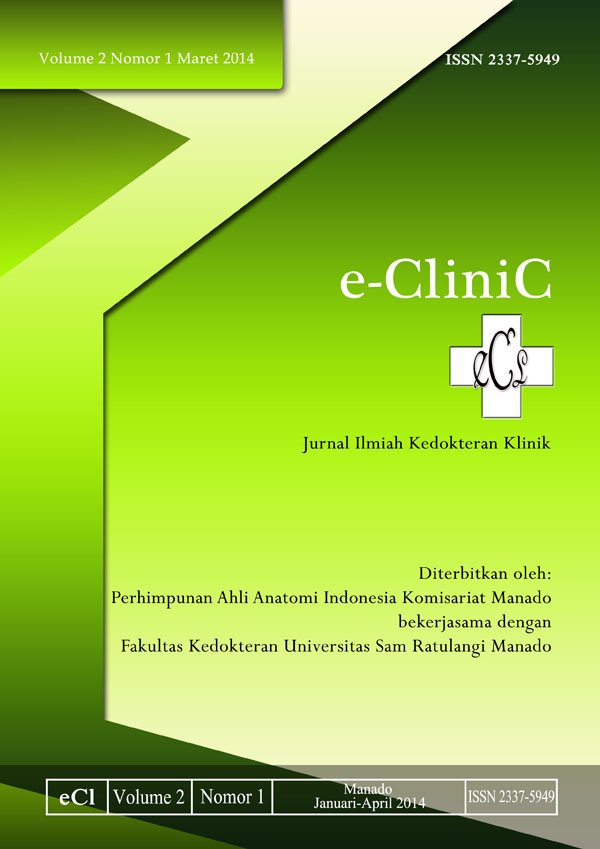Perbandingan Efektifitas Tramadol 1 mg/kgbb + Paracetamol 1 gr Intravena dan Tramadol 1 mg/kgbb + Ketorolak 30 mg Intravena pada Penanganan Nyeri Pasca Pembedahan Sesaria
DOI:
https://doi.org/10.35790/ecl.v2i1.3714Abstract
Absract: Background: A process of pain management can not be separated with anesthesia practice. Pain after section caesaria is the main problem. Because if the pain cannot be managed, it will appearing negative effect and finally will influence the quality of baby treatment by his/her mother. Goal :To know the comparative effectivity of Tramadol 1mg/kg of weight + Paracetamol 1 gr Intravenous and Tramadol 1 mg/ kg of weight + Ketorolac 30 mg Intravenous on pain management after sectio caesaria. Methods : The research using prospective analytic study, with collecting primary data result from pain measurement and elaborating with SPSS Statistic 20 programme. The result being stated in rerate within result test of Mann-Whitney test. Result : Total of research subject is 20 people that devided in two groups, group I : Tramadol 1mg + Ketorolac 30 mg and group II : Tramadol 1mg + Paracetamol 1 mg iv. In a groups of Trmadol + Ketorolac the patient almost 40 years old and in a groups of Tramadol + Paracetamol the patient almost 30 years old. Severe pain in control, only in Tramadol + Ketorolac groups but did not has large different. In moderate pain,Tramadol + Ketorolac groups more than Tramadol + Paracetamol groups. And in lower pain, Tramadol + Paracetamol groups more than Tramadol + Ketorolac groups. Based on Man-Whitney test, conclude that this research totality has P value = 0.088 it is mean this research is different but not meaningful. Conclusions: Paracetamol has more good effectivity than Ketorolac for pain management after sectio caesaria.
Key Word: Pain, Paracetamol, Ketorolac, Tramadol, Sectio Caesaria
Â
Abstrak: Latar Belakang : Proses penanganan nyeri tidak dapat dipisahkan prosesnya dengan praktek anestesi. Nyeri pasca bedah sesar merupakan masalah utama. Karena apabila nyeri tidak diatasi akan menimbulkan dampak negative dan akhirnya akan mempengaruhi kualitas perawatan bayi oleh ibunya.
Tujuan : mengetahui perbandingan efektifitas antara tramadol 1 mg/kgbb + paracetamol 1 gr Intravena dan tramadol 1 mg/kgbb + ketorolak 30 mg intravena pada penanganan nyeri pasca bedah sesar. Metode : Penelitian ini bersifat analitik prospektif, dengan mengumpulkan data primer hasil pengukuran nyeri dan diolah dengan program SPSS Statistic 20. Hasilnya dinyatakan dalam rerate (mean) disertai uji hasil menggunakan uji Mean-Whitney. Hasil : Jumlah subjek penelitian adalah 20 orang yang dibagi menjadi dua kelompok yaitu, kelompok I : mendapat tramadol 1 mg + ketorolak 30 mg iv, kelompok II : mendapat tramadol 1 mg + parasetamol 1 gr iv. Pada kelompok tramadol + ketorolak pasien paling banyak berumur 40-an sedangkan pada kelompok tramadol + parasetamol, pasien yang paling banyak ada pada umur 30-an. Nyeri berat terkontrol hanya ada pada kelompok tramadol + ketorolak tapi tidak memiliki perbedaan yang besar. Pada nyeri sedang kelompok tramadol + ketorolak lebih tinggi daripada kelompok tramadol + parasetamol.Sedangkan pada nyeri ringan kelompok tramadol + parasetamol lebih tinggi dibandingkan tramadol + ketorolak. Berdasarakan uji statistic Mann – Whitney dapat disimpulkan bahwa secara keseluruhan penelitian ini memiliki nilai p = 0,088 yang berarti penelitian ini adalah berbeda tapi tidak bermakna.
Kesimpulan : Parasetamol memiliki tingkat efektifitas yang lebih baik dibandingkan dengan ketorolak untuk mengatasi nyeri pasca bedah sesar.
Kata kunci : Nyeri, Parasetamol, Ketorolak,Tramadol, Pembedahan Sesar.
Downloads
How to Cite
Issue
Section
License
COPYRIGHT
Authors who publish with this journal agree to the following terms:
Authors hold their copyright and grant this journal the privilege of first publication, with the work simultaneously licensed under a Creative Commons Attribution License that permits others to impart the work with an acknowledgment of the work's origin and initial publication by this journal.
Authors can enter into separate or additional contractual arrangements for the non-exclusive distribution of the journal's published version of the work (for example, post it to an institutional repository or publish it in a book), with an acknowledgment of its underlying publication in this journal.
Authors are permitted and encouraged to post their work online (for example, in institutional repositories or on their website) as it can lead to productive exchanges, as well as earlier and greater citation of the published work (See The Effect of Open Access).







